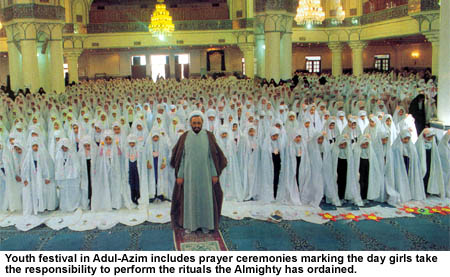
Party hosted by embassy in Sana’a Iran and its revolution [Archives:2003/06/Reportage]
February 10 2003

BY MOHAMMED AL-MASANI
YEMEN TIMES STAFF
A dinner party was hosted by the Irani Embassy in Sana’a in celebration of the 24th anniversary of the Islamic Revolution in Iran on Feb. 4 at the Taj Sheba Hotel.
The party was attended by the diplomats, ambassadors, military men, social dignitaries, journalists and a host of others.
Celebrating the Islamic revolution is a part of the celebration taking place in Iran when helicopters rained flowers over Tehran and sirens wailed across the city last week.
When Imam Khmeini left Iran in 1963, his voice was that of a prominent clergy and recognized Grand Ayatollah who had single-handedly taken on the former Shah’s security bodies.
But on Feb. 1, 1979 when he returned, he was no longer alone, as millions turned out to welcome him, the man who was both an other-worldly mystic and a keen observer of, as well as participant in, worldly affairs.
It took only ten days from the first day that Imam Khomeni arrived in Iran up to the victory of the revolution.
During these ten days, the Imam emerged as the most important revolutionary leader the world had known in the second half of the 20th century.
The Islamic Revolution neither began nor ended in February 1979. Its victory that month was the result of years of struggle and sacrifice by hundreds of people dating at least as far back as the dark days of 1963.
The external signs of the Revolution’s Islamic nature were not difficult to see. Most importantly, they lay in the total condemnation of the west’s immoral and exploitative role in the world, the influence of Zionism and the Jewish occupation of Palestine and the denunciation of the pro-western Muslim regimes.
The experiment of the Islamic State has not been a failure by any means, despite the clamorous propaganda of its enemies.
In fact, huge social changes have been brought about in Iran, including the provision of basic services to Iran’s ordinary people who had been marginalized under the pro-western order, and their empowerment through the reform and massive expansion of the academic system.
Thousands of miles of new roads have been built, electricity, running water and primary health-care was taken into rural areas which had been ignored as irrelevant in Shah’s “modernization” programs, and literacy levels were raised.
In an Islamic society like Iran, which is based on religious foundations, education can materialize religious upbringing of the citizens.
Without any exaggeration, the Islamic scholars have excelled in this field.
Since the first century Hegira, the religious leaders and scholars, relying on the Qura’an and tradition, have forwarded such invaluable works that their contents have become obsolete with the passage of time, confirming the status of Muslim scholars in the arena of thought and method.
——
[archive-e:06-v:2003-y:2003-d:2003-02-10-p:./2003/iss06/report.htm]


